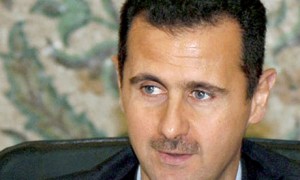 Today I was alerted to the fact that Syria has put down an uprising before, and even more brutally.
Today I was alerted to the fact that Syria has put down an uprising before, and even more brutally.
I happened to come across this cross post on Cifwatch.com by Impartial Eclipse.
The post, written in March, tells us about how in February 1982 the Syrian army enter the city of Hama in central Syria to hunt down anti-Ba’athists.
The anti-Ba’athists were in fact mainly what we would now call ‘Islamists’, some affiliated to the Muslim Brotherhood. This group had already revolted in the past in order to bring down the government of Hafez Assad, the father of the current President of Syria.
These rebel insurgents in Hama were Sunni Muslims. When they attacked and killed Syrian soldiers hunting down the regimes political enemies, what followed was a true massacre of medieval proportions and brutality.
The Syrian army went on a killing spree not just against insurgents but the whole city. In scenes reminiscent of the Nazis who razed whole towns in the Second World War, government forces killed between 10,000 and 40,000 people, men women and children. Exact figures are hard to come by but most commentators now believe that 40,000 is nearer the mark than 10,000.
The city was surrounded and shelled for three weeks. Scenes of unspeakable acts of mutilation and mass executions were reported.
The world did nothing. The Syrian regime remained. The uprising was limited to Hama, and the Muslim Brotherhood was eliminated in Syria, either going to ground or scattering to neighbouring countries, the USA and Great Britain.
Over the past few weeks we have seen that Hafez Assad taught his son, Bashar, well.
A generation later the insurgents have returned. This time they are not necessarily Islamists but from a wide spectrum of Syrian society determined to put an end to decades of the Assad dynasty. What these latterday insurgents want is not always clear, but political rights and greater freedoms are on their agenda. One assumes.
The reaction of the current President Assad is to behave like his father. He, too, is prepared to use tanks and bombs against his own citizens, indiscriminately, to fire on unarmed demonstrators, arrest and detain thousands.
This time it is not just the residents of Hama who are rising up, but also Deraa, Baiyas, Aleppo and Homs. Even the Damascus region has tanks on the streets of its towns.
Not 40,000 dead this time but, according to best estimates about 800. So far, but it could get a loss worse and probably will.
There is a striking comparison to be made between the siege of Deraa where its people have no-one to protect them and Misrata in Libya.
For weeks the Libyan army has pounded the people of Misrata, the front line of the rebel advance. Yet these insurgents are armed and are protected by the most sophisticated air force in the world – that of Nato aided by a few Qataris representing the Arab League.
So what is the difference between Libya and Syria?
According to pundits, the Arabs agreed via the UN Security Council and Resolution 1973 to ‘invite’ Nato to protect Arabs from other Arabs because even this roll-call of oppressive regimes could not stomach the spectacle of Gaddafi killing his own people.
Yet when it comes to Syria not one of them has so much as whispered disapproval. Not the Saudis, not the Egyptians who are now supposed to be paragons of democracy, not the Jordanians and not Assad’s good friends the Turks (until today) and the Iranians (“no need for intervention”).
No international intervention has materialised because the Arabs appear to value the blood of Libyans above that of Syrians, and the UN can just issue its usual mumbled toothless condemnations.
The EU, meanwhile, proclaims sanctions. Big deal.
Apparently, it’s a different situation to Libya because Assad still has the support of his people. Did anyone take a poll in Libya and Syria to determine which regime had most popular support?
The simple truth is that Syria is a ‘player’ a regional power which bestrides the geographic and political ground between Turkey and Iran. Libya, on the other hand, apart from a bit of oil, is of little strategic importance and Gaddafi’s heyday of state terrorism, WMD, assassinations, racism and islamisation are largely in the past.
The recent Arab Spring has shown to what lengths the regimes in the region are prepared to go to preserve power and hegemony; whether it is the racist pragmatist Gaddafi or the Bahraini sheiks, the Ba’athists in Syria or the Shi’ites in Yemen.
Let’s not forget the hundreds who died in Egypt before we proclaim this was a bloodless ‘revolution’.
Despite the West’s wishful thinking that all these Arab uprisings will lead to democracy and the New Millenium, due to the very nature of the regimes in these countries, we have no idea of the motivations, political leanings or any future political outcomes resulting from these uprisings. The West assumes that if you through the pack in the air it will land as a perfect House of Cards, but revolutions and seismic political events leave vacuums into which other dark forces can come which are even more inimical to West and western values.
And in this maelstrom, at the eye of this storm, is Israel being encouraged to make a deal with a Fatah-Hamas coalition to introduce another murderous, undemocratic, Islamist, Jew-hating regime in the region.
An opportunity not to be missed.